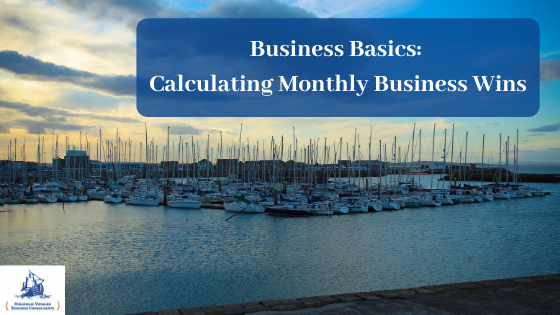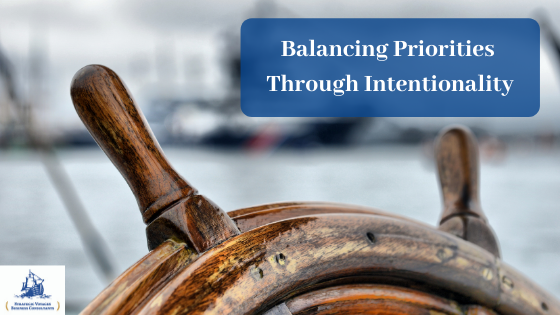Business Basics: Calculating Monthly Business Wins
Business Basics: Calculating Monthly Business Wins
The phone lights up on my desk. I click the green button hoping it’s not another recorded message about insurance or websites or some other “urgent matter.”
“Is this Matt Wilhelmi?” Shot the voice through the phone. Sharp. Direct. I could tell he was frustrated, but I had never heard this voice before.
“Speaking.” Matching his directness and hoping we can shift into a happier tone.
“I got your number from my friend. He said you’ve been helping him with his business for a while now and you’ve even helped structure his whole business so he can golf whenever he wants. Is that true?” His tone had shifted from a busy, rushed sound to a more inquisitive one. I suppose if you want help or advice, being kind helps.
This is how the conversation started with a new client of mine. He was a referral from another client. That’s how you build a sustainable business; deliver excellence, be consistent, and the referrals will flow.
The client who referred me has been a client for quite a while now. Almost 3 years as a matter of fact. And during that time, we’ve gone from 3 employees to over 30 at times, depending on the workflow. The profession is irrelevant. I have clients in all kinds of industries; medical offices, construction companies, athletics, apparel, creative design firms, financial institutions, and even a diamond company.
Do you know why my clients want to work with me? I’ll give you a hint, it’s not because I’m the cheapest business consultant they could find. It’s not because I know more than they do or more than everyone else. I don’t.
Clients want to work with me and my team because we make sure that we follow the Strategic Approach to a T. There’s no room for variance. If someone doesn’t want to follow it, then they likely won’t be a client for long. Why? Because the Strategic Approach is a time-tested and proven methodology for building businesses.
In the next series of blogs, I’ll lay out some of the basics. Interested in learning more? Contact my team today.
The very first step in every engagement with my firm is the SV Analysis. It’s through this process that my team and I gain a thorough understanding of a business’s efforts, goals, losses, and opportunities. It’s how we build the foundation of what defines excellence. Before continuing, I need to tell you a story. A story that helps bring specificity to the initial steps of the Strategic Approach.
The Mexican Fisherman.
The story is about a Mexican Fisherman. Actually, the story is more about how dumb the Harvard MBA sounds trying to tell the Mexican Fisherman how to live his life. Here’s the link to the full story: The Story of the Mexican Fisherman. I first read this story about 5 years ago and it changed my life. The crux of the story is that a Mexican Fisherman sleeps late, hangs out with his wife, plays in a band, enjoys watching his kids grow up, and he doesn’t take his work too seriously. This confuses the Harvard MBA who thinks the Mexican Fisherman should work harder… only to realize that the reward for working harder is to obtain a lifestyle that the Mexican Fisherman already has. I find it ironical that so many “consultants” try to build their clients’ businesses without first making sure they (the consultant) knows where the Client wants to head in life.
The SV Analysis allows my team and I to fully understand a business, the owner(s), and where they want to go and why. It’s critically important to have this part crystalized before delivering advice. The advice needs to align with the goals.
That’s the basics of business; setting goals, outlining the action plan, then finding a team to get there.
To ensure a business owner stays on track, I’ve begun using and redefining the “win” to mean “Accomplishing what I set out to do, in the amount of time I said it would take, and the process was about what I thought it would be.”
Said another way, Calculating Monthly Business Wins helps business owners to set time-sensitive and attainable goals with a short enough feedback loop to constantly improve the process. Having a monthly business objective means that you can clearly and succinctly know if you either “won” a month or “lost” a month. Business is a game. And like any other game, there are winners and losers. There are those who tried hard and lost and there are those who put in the work when no one else was watching and they showed up and won the game.
The new client I mentioned at the beginning of the blog has been a client of mine for about 6 months now. We talk often. We’ve determined what the big picture goal is and now we’re focusing each month of business wins. It’s a simple recipe that helps to stack wins and gain momentum. Winning is contagious. So is self-actualization.
Steps To Calculate Monthly Business Wins
Here’s the basics of how to calculate monthly business wins for yourself.
Step 1 – Determine what the big picture goal is. Be as specific as possible. What do you want your life to look like. What do you want to find enjoyment in. What do you want to spend your time on. How much money do you want to have in the bank.
Step 2 – Evaluate where you are at now. What systems of checks and balances do you have in place to know if you’re headed towards your big picture goal. What tools do you need to get there. What skills do you need to develop. What other people do you need to find to help you get there.
Step 3 – Build the plan with Key Performance Indicators. KPI’s are measurable objectives that you have 100% control of. There can be no excuses for KPI’s. A KPI might be “Made 100 sales calls this week.” You can control that. You can’t control if you close all of them. But, once you’ve made a commitment to the process, then you can tweak the process to get close to the goals.
Some important things to mention.
- You’ll need to learn to say “no” to a lot of things. Things you say “yes” to that aren’t aligned with your big picture goal will undoubtedly sidetrack you and cause you to be distracted. In Taboo Business Questions, I talk about the ability to hyperfocus. It’s a necessary skill in winning; focusing by determining what to pay attention to and what to ignore.
- You’ll probably need an accountability partner. This isn’t a pushover person with no backbone. This isn’t your wife, husband, girlfriend, or romantic interest. This is someone who will look you in the eye and say something like, “Do you want results or do you want to complain about how you lost track of time?”
- You need to track your progress in writing. Like training for a sport, a good athlete will track their progress in lifting weights, eating meals, and their on the field performance. You need to think about business with the same mindset.
- You’ll need to take a break eventually. Don’t over commit yourself and burn out. Even professional athletes have offseasons and down time.
- You’ll need to invest in your mindset. Aside from working a bunch of hours, creating processes, building out the business, and
- Make a commitment to yourself. You can use this format: “I’m going to push for the next ___ weeks. I’m going to say “no” to X, Y, Z activities for a short time because I want to win at business. When I’ve accomplished _____, I’m going to treat myself with _____.”
Remember, make the goals manageable. Focus on the things you can control, not the outcome. Sometimes, you’ll be surprised that the process towards your goals may be more rewarding than the actual goal itself.
Curious – How do you measure if you have a good month in business? How do you calculate monthly business wins?








